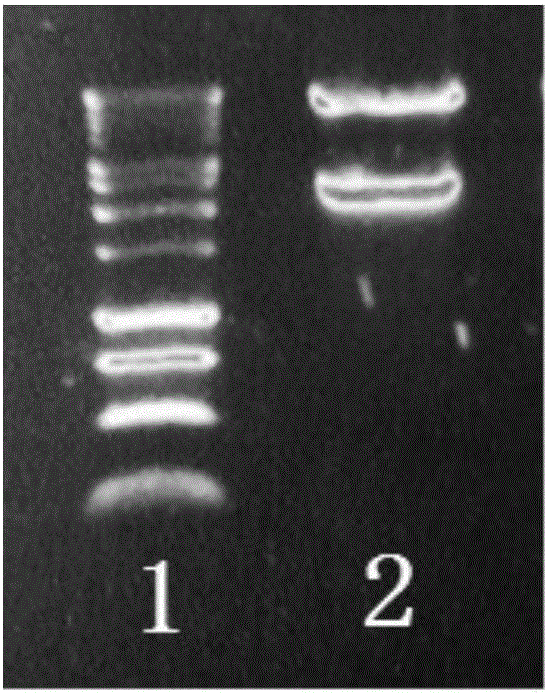CD19 specific chimeric antigen receptor and encoding gene and application thereof
A chimeric antigen receptor and specific technology, applied in the field of cellular immunity, can solve the problems of poor tolerance, strong toxic and side effects, and high recurrence rate
- Summary
- Abstract
- Description
- Claims
- Application Information
AI Technical Summary
Problems solved by technology
Method used
Image
Examples
Embodiment 1
[0031] Example 1: Construction of CD19-specific chimeric antigen receptor retroviral vector
[0032] A CD19-specific chimeric antigen receptor proposed in the present invention is composed of a human anti-CD19 single-chain antibody, the CH2CH3 of human antibody IgG4, the transmembrane region and the intracellular signal structure of CD28, the intracellular signal structure of CD137, and the CD3ζ. The intracellular signal structure of the tandem is composed of tandem, and its amino acid sequence is shown in SEQ ID NO.1.
[0033] 1. Using the FMC62 mouse anti-human CD19 monoclonal antibody sequence published in 1991, select V H and V L The sequence of scFv is used to design the scFv sequence in the CAR vector. The codons are further optimized by GenScript Biotechnology's OptimumGeneTM gene design software, and NcoI and BAMHI restriction sites are added to both ends of the optimized sequence. After optimization The sequence of the gene was synthesized by Nanjing GenScript Biote...
Embodiment 2
[0037] Example 2: Preparation of CD19-specific chimeric antigen receptor-modified T lymphocytes
[0038] 1. Packaging of retrovirus containing CD19-specific chimeric antigen receptor
[0039] The retroviral packaging vector pRD114 and CD19-scFv-CH2CH3-CD28-CD137-CD3ζ retroviral vector were co-transfected into 293T cells using the instructions in the endotoxin-free plasmid extraction kit (Tiangen Biotechnology). The cell supernatant was collected 48h after transfection, centrifuged at 4000rpm for 10min, and the cells and cell debris in the supernatant were removed. Filter through a 0.45 μm filter, aliquot and store for later use.
[0040] 2. Preparation of T lymphocytes
[0041] 20 mL of fresh anticoagulant from healthy volunteers was taken, and peripheral blood mononuclear cells (PBMC) were isolated with lymphatic separation medium (GE). The isolated cells were stimulated with CD3 and CD28 plates for 48 hours, and induced with T lymphocyte medium GT-T551 (TAKARA) plus 3% au...
Embodiment 3
[0046] Example 3: Killing effect of chimeric antigen receptor CD19-specific CAR-T cells on CD19-related tumors
[0047] 1. Detection of lethality of CAR-T cells to tumors
[0048] Adjust the lymphoma cells with medium to 5 × 10 6 / mL, 50 μL per well, according to the ratio of effector cells to target cells 1:4, add 2.5×10 CD19 positive lymphoma cells 5 After the cells are completely attached, collect T cells and CAR-T cells, and adjust the cell concentration to 1.25×10 6 / mL, 50 μL per well, and then flow cytometry (cultured for 24h) and MTT detection (cultured for 12h) were performed.
[0049] First, cells were collected for CD3 and CD19 staining, and flow cytometric analysis of tumor cells (CD19 + ) and T cells (CD3 + ), the result is as Figure 5 shown. Depend on Figure 5 It can be seen that the chimeric antigen receptor CD19-specific CAR-T cells obtained in the present invention can effectively kill lymphoma cells.
[0050] Next, in the same experiment, discard th...
PUM
 Login to View More
Login to View More Abstract
Description
Claims
Application Information
 Login to View More
Login to View More - R&D
- Intellectual Property
- Life Sciences
- Materials
- Tech Scout
- Unparalleled Data Quality
- Higher Quality Content
- 60% Fewer Hallucinations
Browse by: Latest US Patents, China's latest patents, Technical Efficacy Thesaurus, Application Domain, Technology Topic, Popular Technical Reports.
© 2025 PatSnap. All rights reserved.Legal|Privacy policy|Modern Slavery Act Transparency Statement|Sitemap|About US| Contact US: help@patsnap.com



